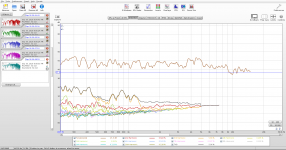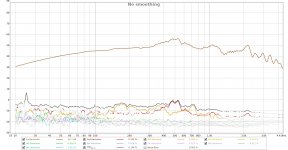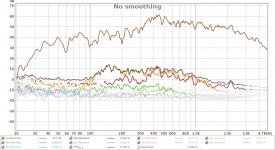Hello,
I just bought pair of Faital 15FH500 and did some quick measurements (free air) in REW. I want to use it up to 1kHz.
It seems distortion at low volume is high in midrange:
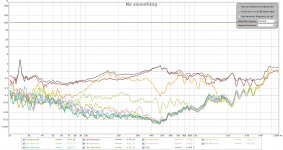
Will break-in reduce distortion? Or is this normal?
I just bought pair of Faital 15FH500 and did some quick measurements (free air) in REW. I want to use it up to 1kHz.
It seems distortion at low volume is high in midrange:

Will break-in reduce distortion? Or is this normal?
did some quick measurements (free air) in REW [...] is this normal?
Are you actually measuring distortion?
Where I live / do stuff, I have to be really suspicious / careful with distortion and low level tests - the noise floor is often not low enough.
e.g. I'll get what looks looks like a high distortion level... then I'll realise that an idling car engine or burner for a water heater has ruined the noise floor. Outdoors, what seems like a quiet gentle breeze or distant insects can ruin it.
What your brain filters out as background (unimportant), a mic cannot.
In a free-air measurement the noises coming from suspension and ventilation are not masked by enclosure. These noises are rich in harmonics. The measurements in free air are not represntative of driver performance placed in an enclosure. (This also implies that open-baffle applications are tricky in the sense that driver suspension and ventilation must be quiet enough.)
Note that the distortion in the OPs post is plotted as a percentage relative to the fundamental, not absolute level as in your plot. The same information is contained in both presentation styles.View attachment 708710
Attaching a recent measurement for SPL and clicked the Distortion tab. I would expect the fundamental to follow frequency response and not be flat. I am guessing something is not right with the method of measuring in this case.
Plot the absolute levels of distortion. If they are smooth, they are likely to be your noise floor. Another indication that you are measuring the noise floor is when higher harmonics are not lower than lower ones. Still another one: the Beta version of REW shows the noise floor.
Microphones can also add distortion, especially in near field measurements. Sometimes it already is 1% THD at 110 dB. 110 dB is easily reached in near field measurements.
Microphones can also add distortion, especially in near field measurements. Sometimes it already is 1% THD at 110 dB. 110 dB is easily reached in near field measurements.
This is because I enabled "Plot normalised to foundemental".I would expect the fundamental to follow frequency response and not be flat.
I measured speaker with much lower distortion with same mic, but different sound card and amplifier.How clean is the test equipment?
Maybe it could be computer fans, but I positioned mic very close to speaker. I will try to measure again with different sound card and no computer fans.Are you actually measuring distortion?
Where I live / do stuff, I have to be really suspicious / careful with distortion and low level tests - the noise floor is often not low enough.
e.g. I'll get what looks looks like a high distortion level... then I'll realise that an idling car engine or burner for a water heater has ruined the noise floor. Outdoors, what seems like a quiet gentle breeze or distant insects can ruin it.
What your brain filters out as background (unimportant), a mic cannot.
Last edited:
What is odd to me is that you have a certain feature at ~480Hz on the 2nd order harmonic which suggests a tone/breakup at 960Hz or so, which is quite plausible for a 15" driver.
However, the same feature appears on the 3rd harmonic with the wrong multiple. In your plot, the features at 480Hz on the 2nd harmonic appears the same as a feature on the 3rd harmonic at 160Hz. Usually when you see a distinct feature like that in a HD plot it directly corresponds to the frequency response or ambient noise which is fixed in frequency for the entire sweep i.e. for 3rd harmonic, you would expect 960Hz/3 = 320Hz. Instead, we are at half this frequency for some reason. To me this suggests that the problem is neither the driver nor background noise. The 1% distortion on the 2nd and 3rd harmonic is definitely not white noise like computer fans - they tend to produce white noise which will bring up the noise floor of you measurement i.e. where all you higher harmonics are bunched up around 0.01-0.02%, they will come up a bit with increasing fan noise.
I would double check your test setup, in particular check that your sound card and/or software is not performing re-sampling or has some DSP feature enabled.
At 1% THD, the sweep would not sound clean to your ears either. Instead of being a clean sine wave it should start to sound a bit like a square wave due to the harmonics.
However, the same feature appears on the 3rd harmonic with the wrong multiple. In your plot, the features at 480Hz on the 2nd harmonic appears the same as a feature on the 3rd harmonic at 160Hz. Usually when you see a distinct feature like that in a HD plot it directly corresponds to the frequency response or ambient noise which is fixed in frequency for the entire sweep i.e. for 3rd harmonic, you would expect 960Hz/3 = 320Hz. Instead, we are at half this frequency for some reason. To me this suggests that the problem is neither the driver nor background noise. The 1% distortion on the 2nd and 3rd harmonic is definitely not white noise like computer fans - they tend to produce white noise which will bring up the noise floor of you measurement i.e. where all you higher harmonics are bunched up around 0.01-0.02%, they will come up a bit with increasing fan noise.
I would double check your test setup, in particular check that your sound card and/or software is not performing re-sampling or has some DSP feature enabled.
At 1% THD, the sweep would not sound clean to your ears either. Instead of being a clean sine wave it should start to sound a bit like a square wave due to the harmonics.
Last edited:
Also check the sound pressure level at the microphone, it strongly affects microphone distortion.I measured speaker with much lower distortion with same mic, but different sound card and amplifier.
Thank you all for all suggestions.
I measured with different sound card and using REW 5.19 with computer in different room.
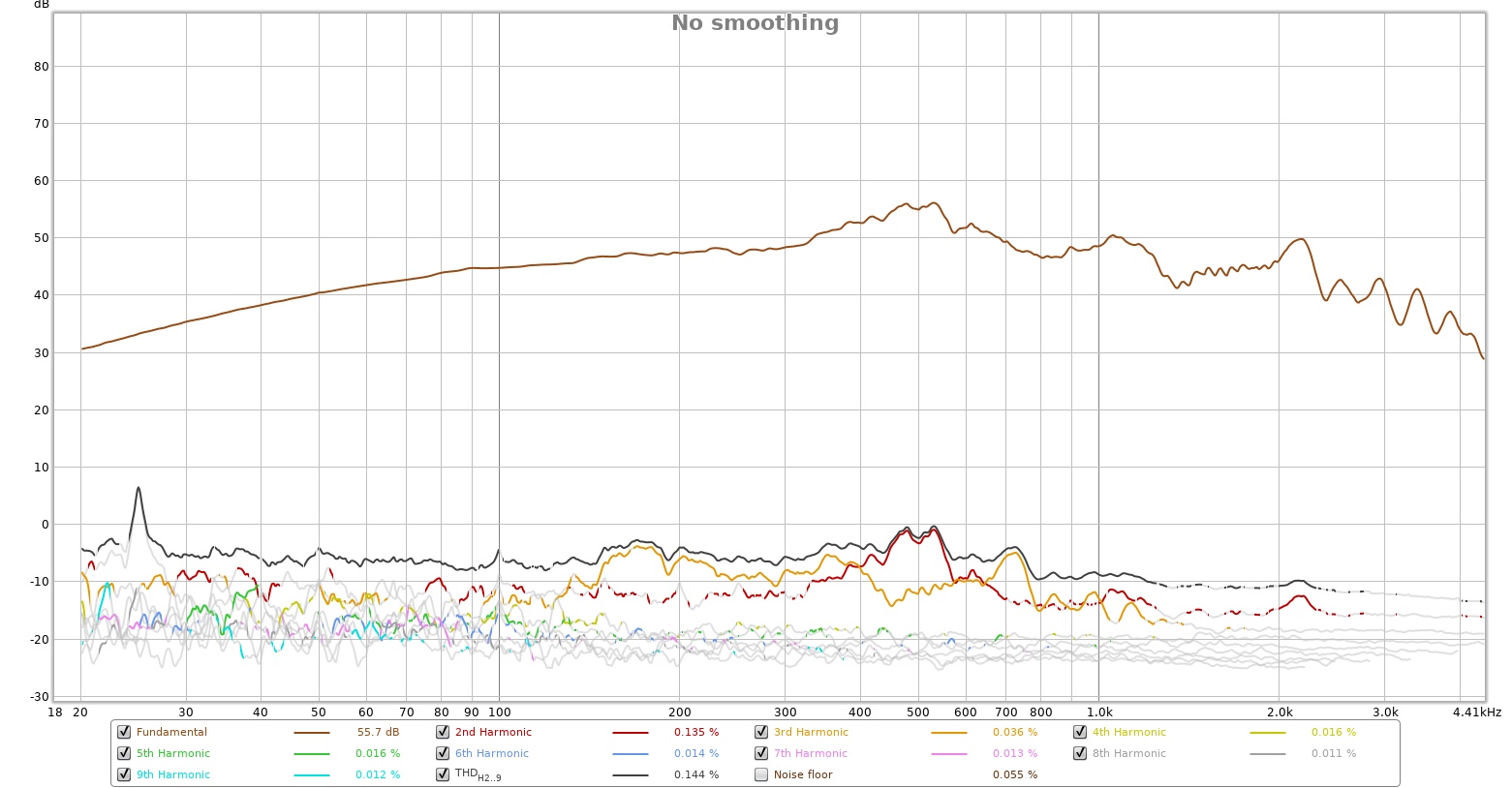
At even lower volume it seems much better. Because I wasn't sure, if mic is distorting, I used my ears. Indeed I could hear a lot of distortion at high volume.
I found that some distortion seems to be caused by amplifier top panel vibrating (around 470Hz), chair legs, and probably other stuff.
After removing chair I set amplifier a bit louder and listened just sine waves and there was some obvious clipping.
I suspect amplifier (it's Technics from 90s, supposed to be 40W) is causing most of distortion. So I will try different amplifier (not sure, if it is any better) this weekend. Maybe outside.
Here is REW file of all measurements.
I measured with different sound card and using REW 5.19 with computer in different room.
At even lower volume it seems much better. Because I wasn't sure, if mic is distorting, I used my ears. Indeed I could hear a lot of distortion at high volume.
I found that some distortion seems to be caused by amplifier top panel vibrating (around 470Hz), chair legs, and probably other stuff.
After removing chair I set amplifier a bit louder and listened just sine waves and there was some obvious clipping.
I suspect amplifier (it's Technics from 90s, supposed to be 40W) is causing most of distortion. So I will try different amplifier (not sure, if it is any better) this weekend. Maybe outside.
Here is REW file of all measurements.
Attachments
I didn't measure volume or voltage, but low enough mic (Behringer ECM8000) didn't distort at ~10 cm distance.And how low is "low volume" ?
My current speakers play well at low volume. So I want new ones to be able to play nice very loud. I'm sure it will be better when they will be in box.Keep in mind that things change dramatically as soon as they are in boxes and run as a pair. That low power may suddenly sound quite loud !
Beyma TPL-150H.What do you plan on running above 1khz?
I did another measurement with newer amplifier:
It seems good, but I kinda expected it to be better, because all that surface area.
Attachments
I think you have a catch22 trying to measure distortion on a strong sub/lower mid indoors.
If you're at a SPL low enough not to excite room/object resonances, noise floor bums up the measurement.
If you climb above the noise floor significantly, you excite all kinds of resonances in all kinds of room objects.
I'd take it outside if you can, and test at about 110-120dB/ 1meter.
If you're at a SPL low enough not to excite room/object resonances, noise floor bums up the measurement.
If you climb above the noise floor significantly, you excite all kinds of resonances in all kinds of room objects.
I'd take it outside if you can, and test at about 110-120dB/ 1meter.
No, that test was about 5m, to prevent mic distortion. However, this probably excited many resonances.LightBit, is that test still at 10cm (4") ? Why not 1/2 meter with that large of a driver?
That would be better way, but I would first need amplifier capable of doing that and hope neighbors won't kill me.I'd take it outside if you can, and test at about 110-120dB/ 1meter.
Maybe, when they are finished.
- Status
- This old topic is closed. If you want to reopen this topic, contact a moderator using the "Report Post" button.
- Home
- Live Sound
- PA Systems
- Midrange distortion on 15" PA driver
